BUSN 20017 Strategic Management: A Reflective Essay on Communication
VerifiedAdded on 2023/06/03
|10
|2620
|256
Essay
AI Summary
This reflective essay explores the concept of strategic management with a focus on communication, drawing from the week 7, week 8 and week 10 modules. It emphasizes the importance of intercultural, organizational, and interpersonal communication in today's globalized business environment. The essay discusses how effective communication fosters strong team bonds, promotes diversity, and enhances overall organizational performance. The author reflects on personal learning experiences and how these communication skills will contribute to professional growth in the next five years, highlighting the need for cultural awareness, clear internal communication, and assertive interpersonal skills to navigate the rapidly changing industry dynamics. The essay concludes that mastering these communication methods is crucial for developing and maintaining a successful professional career.
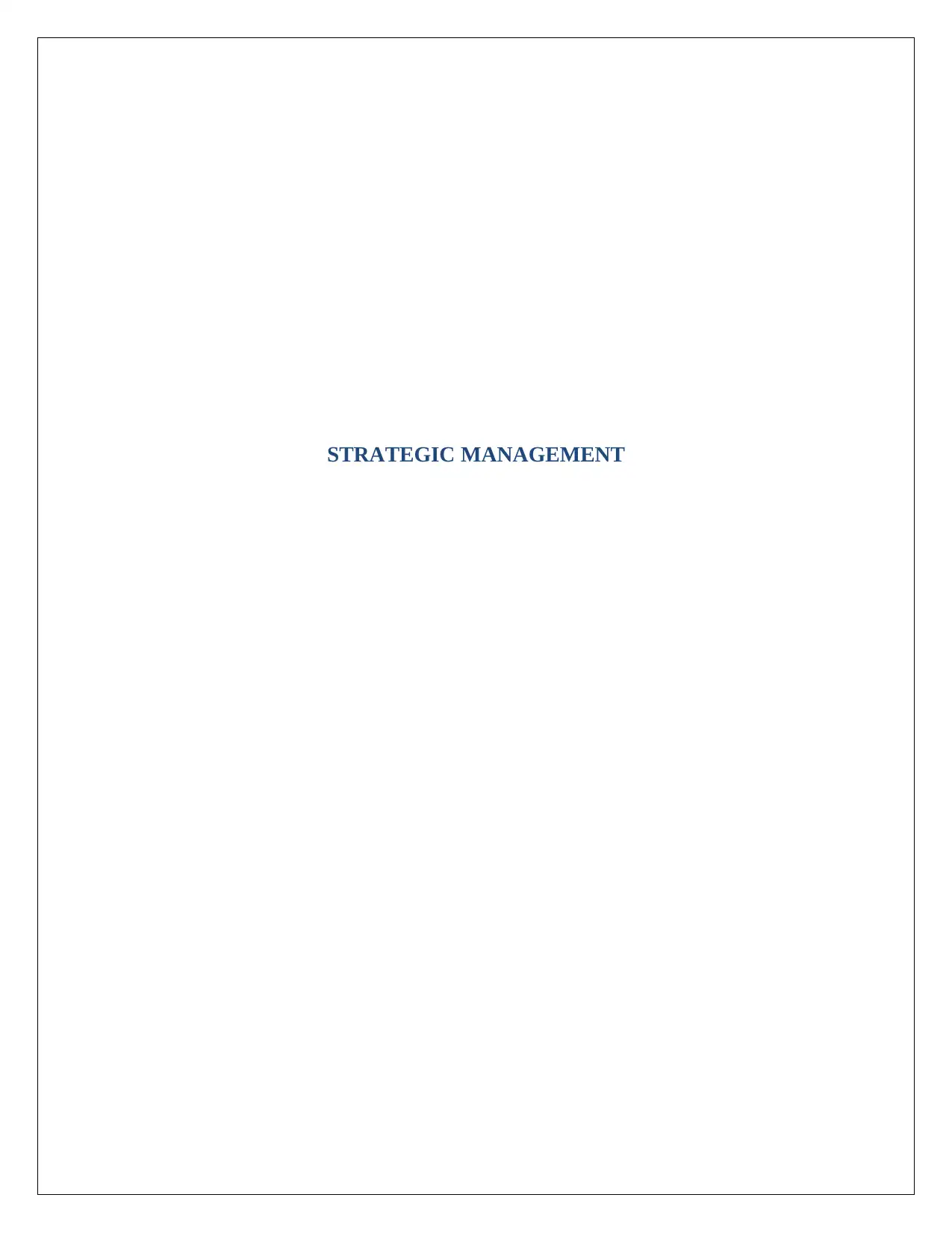
STRATEGIC MANAGEMENT
Paraphrase This Document
Need a fresh take? Get an instant paraphrase of this document with our AI Paraphraser
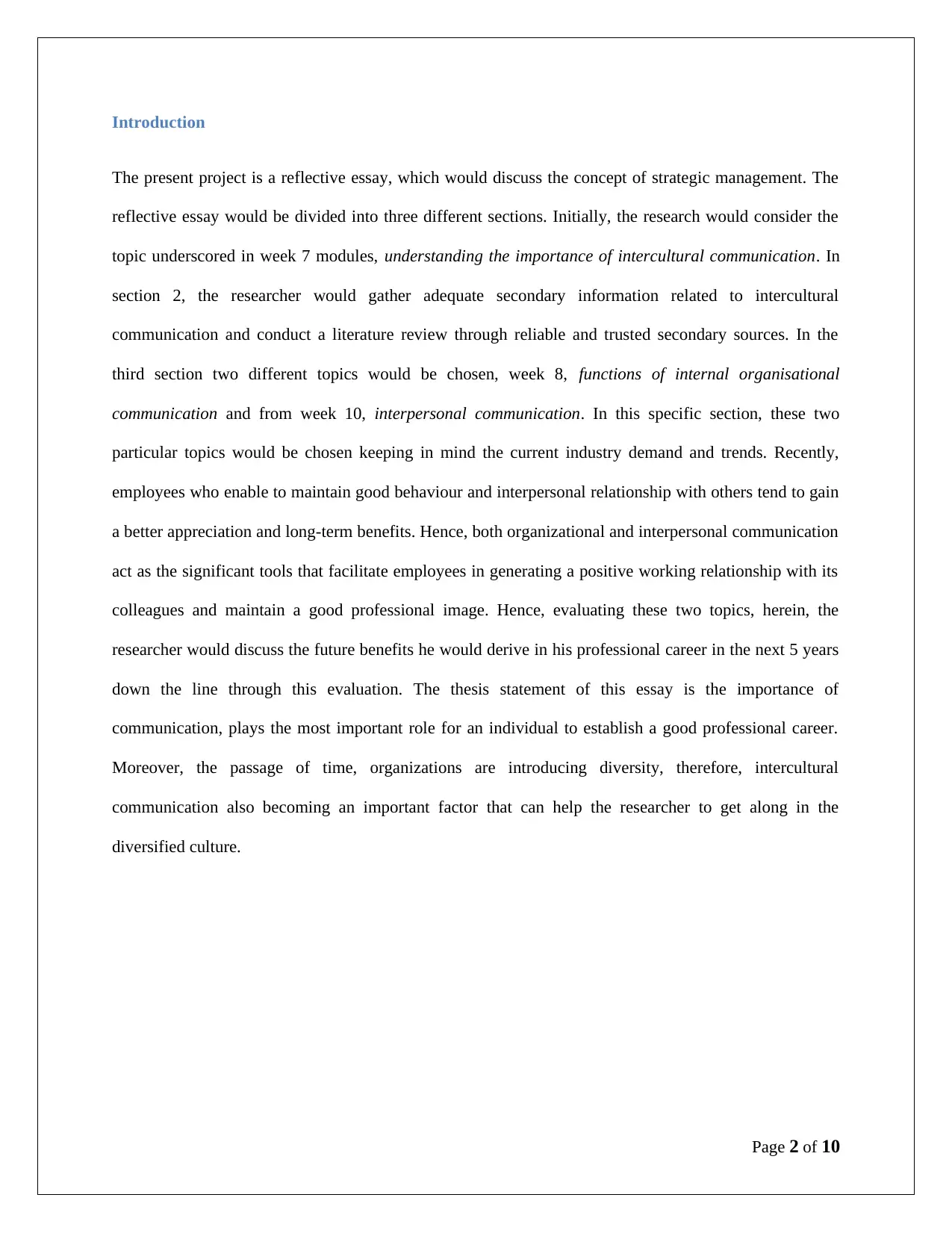
Introduction
The present project is a reflective essay, which would discuss the concept of strategic management. The
reflective essay would be divided into three different sections. Initially, the research would consider the
topic underscored in week 7 modules, understanding the importance of intercultural communication. In
section 2, the researcher would gather adequate secondary information related to intercultural
communication and conduct a literature review through reliable and trusted secondary sources. In the
third section two different topics would be chosen, week 8, functions of internal organisational
communication and from week 10, interpersonal communication. In this specific section, these two
particular topics would be chosen keeping in mind the current industry demand and trends. Recently,
employees who enable to maintain good behaviour and interpersonal relationship with others tend to gain
a better appreciation and long-term benefits. Hence, both organizational and interpersonal communication
act as the significant tools that facilitate employees in generating a positive working relationship with its
colleagues and maintain a good professional image. Hence, evaluating these two topics, herein, the
researcher would discuss the future benefits he would derive in his professional career in the next 5 years
down the line through this evaluation. The thesis statement of this essay is the importance of
communication, plays the most important role for an individual to establish a good professional career.
Moreover, the passage of time, organizations are introducing diversity, therefore, intercultural
communication also becoming an important factor that can help the researcher to get along in the
diversified culture.
Page 2 of 10
The present project is a reflective essay, which would discuss the concept of strategic management. The
reflective essay would be divided into three different sections. Initially, the research would consider the
topic underscored in week 7 modules, understanding the importance of intercultural communication. In
section 2, the researcher would gather adequate secondary information related to intercultural
communication and conduct a literature review through reliable and trusted secondary sources. In the
third section two different topics would be chosen, week 8, functions of internal organisational
communication and from week 10, interpersonal communication. In this specific section, these two
particular topics would be chosen keeping in mind the current industry demand and trends. Recently,
employees who enable to maintain good behaviour and interpersonal relationship with others tend to gain
a better appreciation and long-term benefits. Hence, both organizational and interpersonal communication
act as the significant tools that facilitate employees in generating a positive working relationship with its
colleagues and maintain a good professional image. Hence, evaluating these two topics, herein, the
researcher would discuss the future benefits he would derive in his professional career in the next 5 years
down the line through this evaluation. The thesis statement of this essay is the importance of
communication, plays the most important role for an individual to establish a good professional career.
Moreover, the passage of time, organizations are introducing diversity, therefore, intercultural
communication also becoming an important factor that can help the researcher to get along in the
diversified culture.
Page 2 of 10
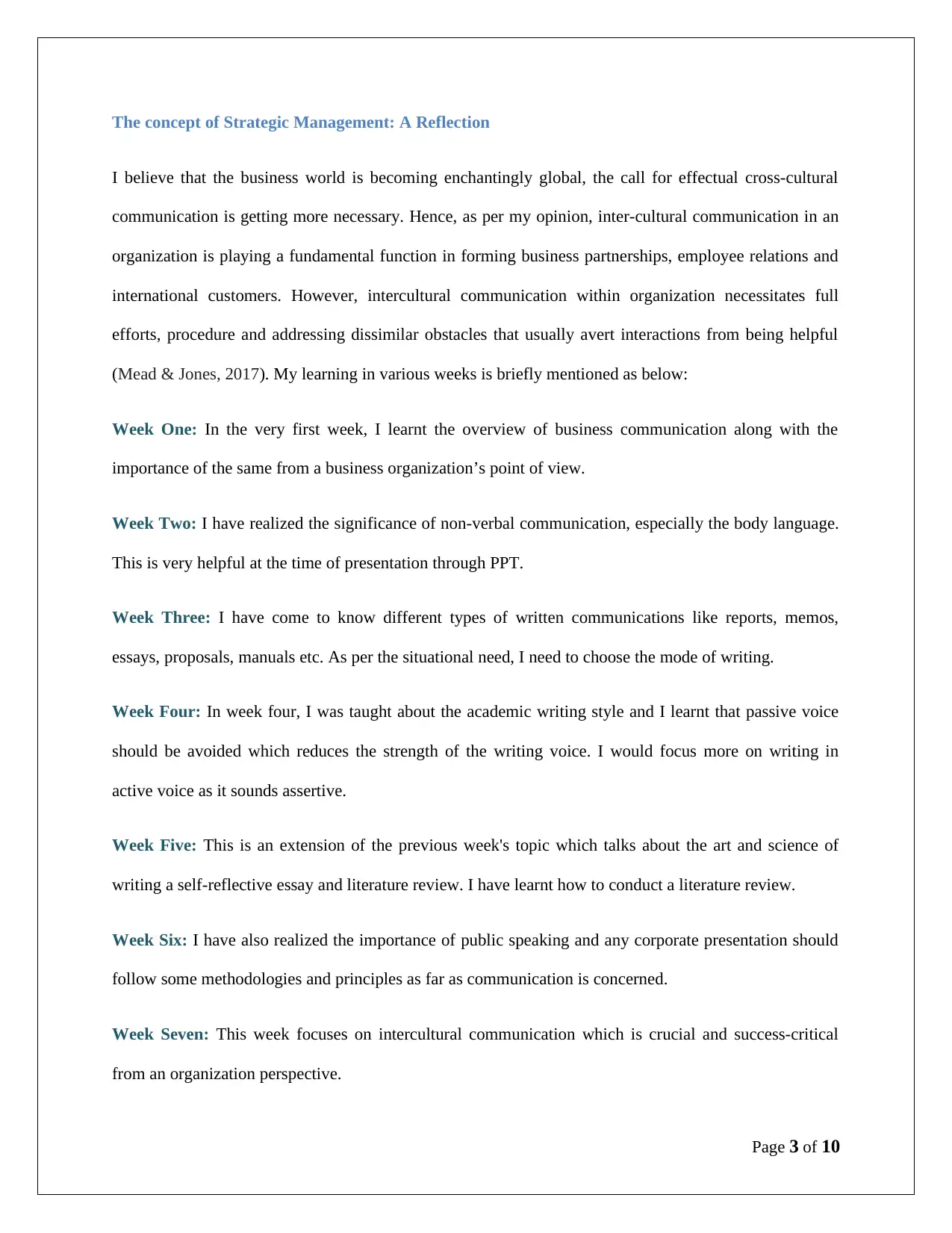
The concept of Strategic Management: A Reflection
I believe that the business world is becoming enchantingly global, the call for effectual cross-cultural
communication is getting more necessary. Hence, as per my opinion, inter-cultural communication in an
organization is playing a fundamental function in forming business partnerships, employee relations and
international customers. However, intercultural communication within organization necessitates full
efforts, procedure and addressing dissimilar obstacles that usually avert interactions from being helpful
(Mead & Jones, 2017). My learning in various weeks is briefly mentioned as below:
Week One: In the very first week, I learnt the overview of business communication along with the
importance of the same from a business organization’s point of view.
Week Two: I have realized the significance of non-verbal communication, especially the body language.
This is very helpful at the time of presentation through PPT.
Week Three: I have come to know different types of written communications like reports, memos,
essays, proposals, manuals etc. As per the situational need, I need to choose the mode of writing.
Week Four: In week four, I was taught about the academic writing style and I learnt that passive voice
should be avoided which reduces the strength of the writing voice. I would focus more on writing in
active voice as it sounds assertive.
Week Five: This is an extension of the previous week's topic which talks about the art and science of
writing a self-reflective essay and literature review. I have learnt how to conduct a literature review.
Week Six: I have also realized the importance of public speaking and any corporate presentation should
follow some methodologies and principles as far as communication is concerned.
Week Seven: This week focuses on intercultural communication which is crucial and success-critical
from an organization perspective.
Page 3 of 10
I believe that the business world is becoming enchantingly global, the call for effectual cross-cultural
communication is getting more necessary. Hence, as per my opinion, inter-cultural communication in an
organization is playing a fundamental function in forming business partnerships, employee relations and
international customers. However, intercultural communication within organization necessitates full
efforts, procedure and addressing dissimilar obstacles that usually avert interactions from being helpful
(Mead & Jones, 2017). My learning in various weeks is briefly mentioned as below:
Week One: In the very first week, I learnt the overview of business communication along with the
importance of the same from a business organization’s point of view.
Week Two: I have realized the significance of non-verbal communication, especially the body language.
This is very helpful at the time of presentation through PPT.
Week Three: I have come to know different types of written communications like reports, memos,
essays, proposals, manuals etc. As per the situational need, I need to choose the mode of writing.
Week Four: In week four, I was taught about the academic writing style and I learnt that passive voice
should be avoided which reduces the strength of the writing voice. I would focus more on writing in
active voice as it sounds assertive.
Week Five: This is an extension of the previous week's topic which talks about the art and science of
writing a self-reflective essay and literature review. I have learnt how to conduct a literature review.
Week Six: I have also realized the importance of public speaking and any corporate presentation should
follow some methodologies and principles as far as communication is concerned.
Week Seven: This week focuses on intercultural communication which is crucial and success-critical
from an organization perspective.
Page 3 of 10
⊘ This is a preview!⊘
Do you want full access?
Subscribe today to unlock all pages.

Trusted by 1+ million students worldwide
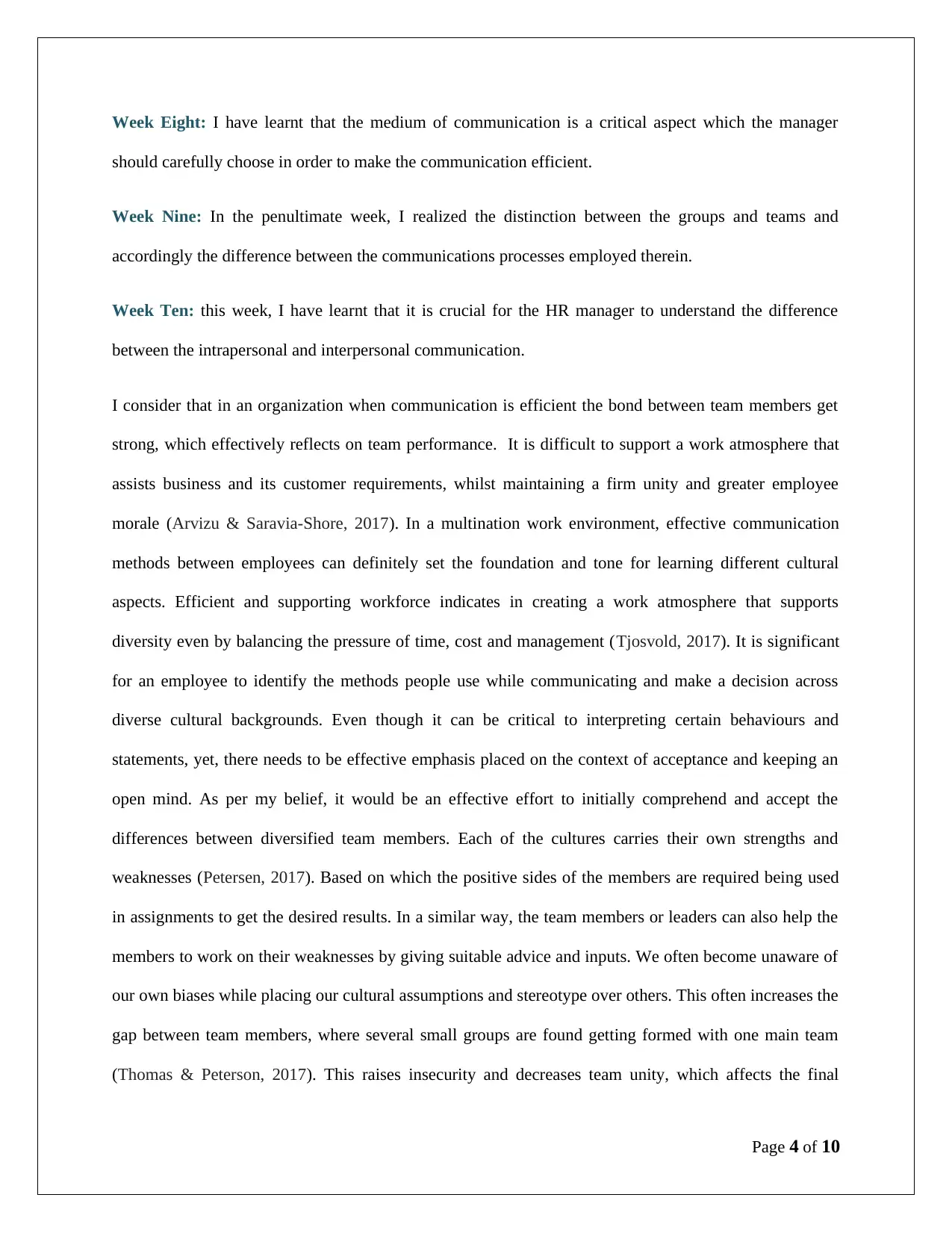
Week Eight: I have learnt that the medium of communication is a critical aspect which the manager
should carefully choose in order to make the communication efficient.
Week Nine: In the penultimate week, I realized the distinction between the groups and teams and
accordingly the difference between the communications processes employed therein.
Week Ten: this week, I have learnt that it is crucial for the HR manager to understand the difference
between the intrapersonal and interpersonal communication.
I consider that in an organization when communication is efficient the bond between team members get
strong, which effectively reflects on team performance. It is difficult to support a work atmosphere that
assists business and its customer requirements, whilst maintaining a firm unity and greater employee
morale (Arvizu & Saravia-Shore, 2017). In a multination work environment, effective communication
methods between employees can definitely set the foundation and tone for learning different cultural
aspects. Efficient and supporting workforce indicates in creating a work atmosphere that supports
diversity even by balancing the pressure of time, cost and management (Tjosvold, 2017). It is significant
for an employee to identify the methods people use while communicating and make a decision across
diverse cultural backgrounds. Even though it can be critical to interpreting certain behaviours and
statements, yet, there needs to be effective emphasis placed on the context of acceptance and keeping an
open mind. As per my belief, it would be an effective effort to initially comprehend and accept the
differences between diversified team members. Each of the cultures carries their own strengths and
weaknesses (Petersen, 2017). Based on which the positive sides of the members are required being used
in assignments to get the desired results. In a similar way, the team members or leaders can also help the
members to work on their weaknesses by giving suitable advice and inputs. We often become unaware of
our own biases while placing our cultural assumptions and stereotype over others. This often increases the
gap between team members, where several small groups are found getting formed with one main team
(Thomas & Peterson, 2017). This raises insecurity and decreases team unity, which affects the final
Page 4 of 10
should carefully choose in order to make the communication efficient.
Week Nine: In the penultimate week, I realized the distinction between the groups and teams and
accordingly the difference between the communications processes employed therein.
Week Ten: this week, I have learnt that it is crucial for the HR manager to understand the difference
between the intrapersonal and interpersonal communication.
I consider that in an organization when communication is efficient the bond between team members get
strong, which effectively reflects on team performance. It is difficult to support a work atmosphere that
assists business and its customer requirements, whilst maintaining a firm unity and greater employee
morale (Arvizu & Saravia-Shore, 2017). In a multination work environment, effective communication
methods between employees can definitely set the foundation and tone for learning different cultural
aspects. Efficient and supporting workforce indicates in creating a work atmosphere that supports
diversity even by balancing the pressure of time, cost and management (Tjosvold, 2017). It is significant
for an employee to identify the methods people use while communicating and make a decision across
diverse cultural backgrounds. Even though it can be critical to interpreting certain behaviours and
statements, yet, there needs to be effective emphasis placed on the context of acceptance and keeping an
open mind. As per my belief, it would be an effective effort to initially comprehend and accept the
differences between diversified team members. Each of the cultures carries their own strengths and
weaknesses (Petersen, 2017). Based on which the positive sides of the members are required being used
in assignments to get the desired results. In a similar way, the team members or leaders can also help the
members to work on their weaknesses by giving suitable advice and inputs. We often become unaware of
our own biases while placing our cultural assumptions and stereotype over others. This often increases the
gap between team members, where several small groups are found getting formed with one main team
(Thomas & Peterson, 2017). This raises insecurity and decreases team unity, which affects the final
Page 4 of 10
Paraphrase This Document
Need a fresh take? Get an instant paraphrase of this document with our AI Paraphraser
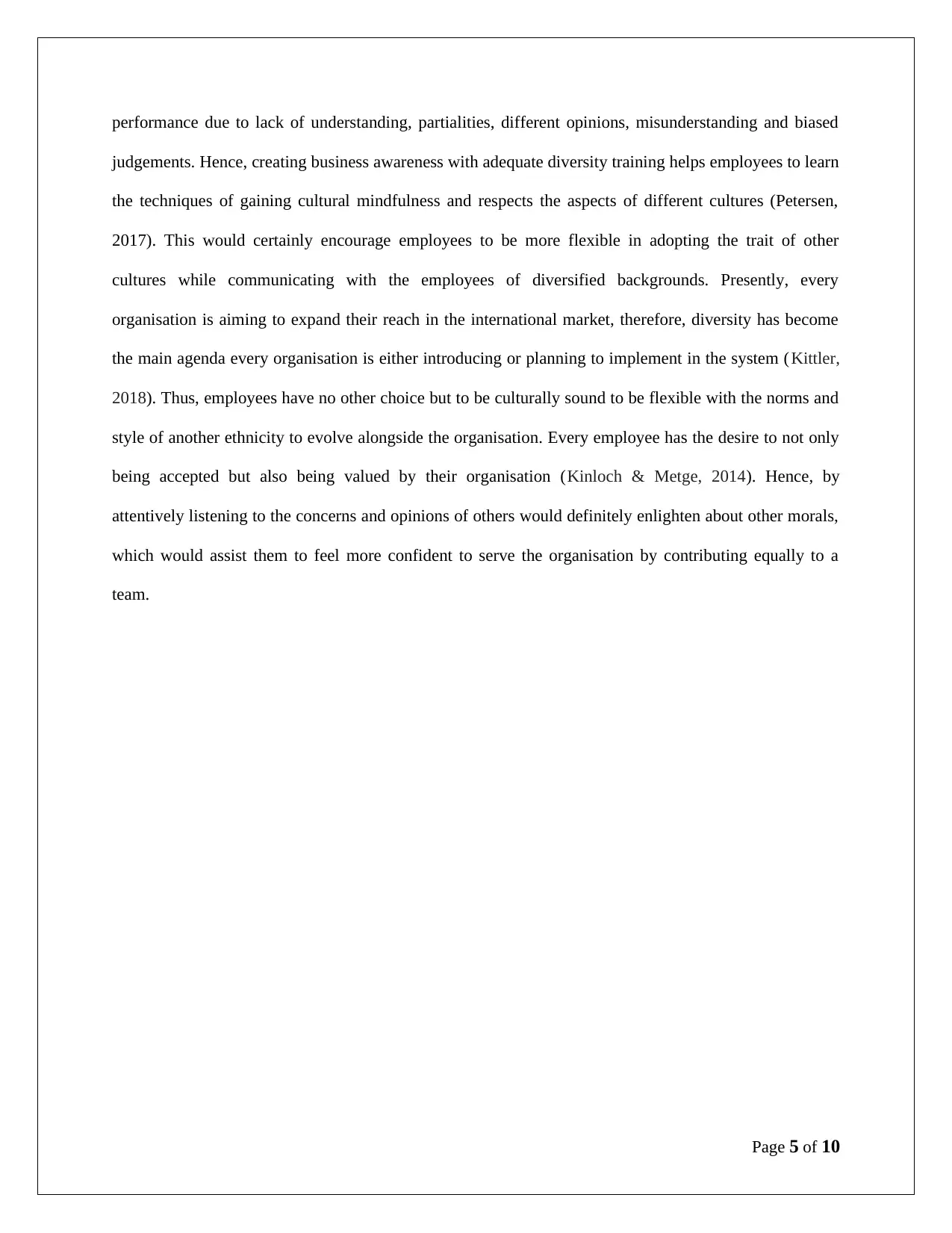
performance due to lack of understanding, partialities, different opinions, misunderstanding and biased
judgements. Hence, creating business awareness with adequate diversity training helps employees to learn
the techniques of gaining cultural mindfulness and respects the aspects of different cultures (Petersen,
2017). This would certainly encourage employees to be more flexible in adopting the trait of other
cultures while communicating with the employees of diversified backgrounds. Presently, every
organisation is aiming to expand their reach in the international market, therefore, diversity has become
the main agenda every organisation is either introducing or planning to implement in the system (Kittler,
2018). Thus, employees have no other choice but to be culturally sound to be flexible with the norms and
style of another ethnicity to evolve alongside the organisation. Every employee has the desire to not only
being accepted but also being valued by their organisation (Kinloch & Metge, 2014). Hence, by
attentively listening to the concerns and opinions of others would definitely enlighten about other morals,
which would assist them to feel more confident to serve the organisation by contributing equally to a
team.
Page 5 of 10
judgements. Hence, creating business awareness with adequate diversity training helps employees to learn
the techniques of gaining cultural mindfulness and respects the aspects of different cultures (Petersen,
2017). This would certainly encourage employees to be more flexible in adopting the trait of other
cultures while communicating with the employees of diversified backgrounds. Presently, every
organisation is aiming to expand their reach in the international market, therefore, diversity has become
the main agenda every organisation is either introducing or planning to implement in the system (Kittler,
2018). Thus, employees have no other choice but to be culturally sound to be flexible with the norms and
style of another ethnicity to evolve alongside the organisation. Every employee has the desire to not only
being accepted but also being valued by their organisation (Kinloch & Metge, 2014). Hence, by
attentively listening to the concerns and opinions of others would definitely enlighten about other morals,
which would assist them to feel more confident to serve the organisation by contributing equally to a
team.
Page 5 of 10
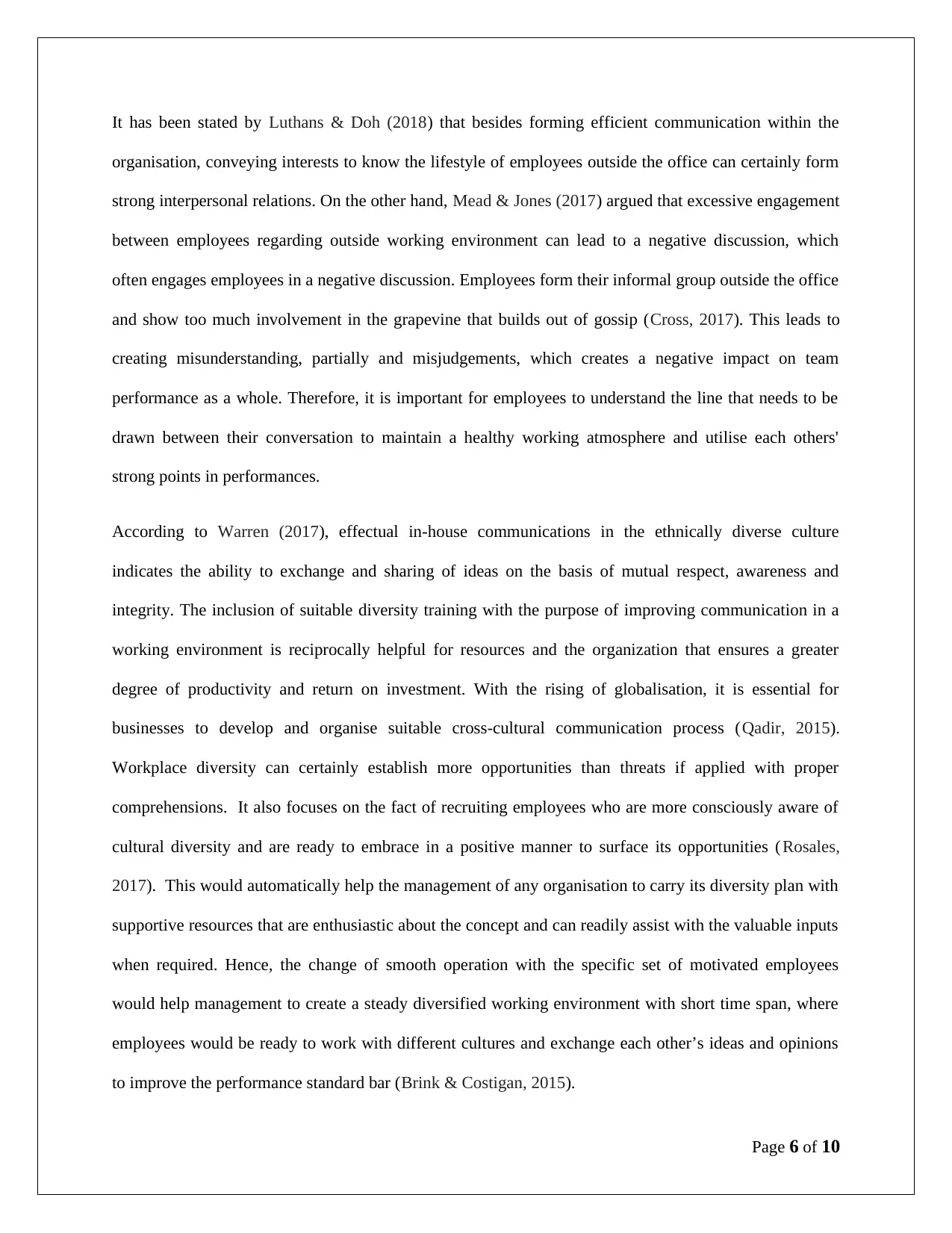
It has been stated by Luthans & Doh (2018) that besides forming efficient communication within the
organisation, conveying interests to know the lifestyle of employees outside the office can certainly form
strong interpersonal relations. On the other hand, Mead & Jones (2017) argued that excessive engagement
between employees regarding outside working environment can lead to a negative discussion, which
often engages employees in a negative discussion. Employees form their informal group outside the office
and show too much involvement in the grapevine that builds out of gossip (Cross, 2017). This leads to
creating misunderstanding, partially and misjudgements, which creates a negative impact on team
performance as a whole. Therefore, it is important for employees to understand the line that needs to be
drawn between their conversation to maintain a healthy working atmosphere and utilise each others'
strong points in performances.
According to Warren (2017), effectual in-house communications in the ethnically diverse culture
indicates the ability to exchange and sharing of ideas on the basis of mutual respect, awareness and
integrity. The inclusion of suitable diversity training with the purpose of improving communication in a
working environment is reciprocally helpful for resources and the organization that ensures a greater
degree of productivity and return on investment. With the rising of globalisation, it is essential for
businesses to develop and organise suitable cross-cultural communication process (Qadir, 2015).
Workplace diversity can certainly establish more opportunities than threats if applied with proper
comprehensions. It also focuses on the fact of recruiting employees who are more consciously aware of
cultural diversity and are ready to embrace in a positive manner to surface its opportunities ( Rosales,
2017). This would automatically help the management of any organisation to carry its diversity plan with
supportive resources that are enthusiastic about the concept and can readily assist with the valuable inputs
when required. Hence, the change of smooth operation with the specific set of motivated employees
would help management to create a steady diversified working environment with short time span, where
employees would be ready to work with different cultures and exchange each other’s ideas and opinions
to improve the performance standard bar (Brink & Costigan, 2015).
Page 6 of 10
organisation, conveying interests to know the lifestyle of employees outside the office can certainly form
strong interpersonal relations. On the other hand, Mead & Jones (2017) argued that excessive engagement
between employees regarding outside working environment can lead to a negative discussion, which
often engages employees in a negative discussion. Employees form their informal group outside the office
and show too much involvement in the grapevine that builds out of gossip (Cross, 2017). This leads to
creating misunderstanding, partially and misjudgements, which creates a negative impact on team
performance as a whole. Therefore, it is important for employees to understand the line that needs to be
drawn between their conversation to maintain a healthy working atmosphere and utilise each others'
strong points in performances.
According to Warren (2017), effectual in-house communications in the ethnically diverse culture
indicates the ability to exchange and sharing of ideas on the basis of mutual respect, awareness and
integrity. The inclusion of suitable diversity training with the purpose of improving communication in a
working environment is reciprocally helpful for resources and the organization that ensures a greater
degree of productivity and return on investment. With the rising of globalisation, it is essential for
businesses to develop and organise suitable cross-cultural communication process (Qadir, 2015).
Workplace diversity can certainly establish more opportunities than threats if applied with proper
comprehensions. It also focuses on the fact of recruiting employees who are more consciously aware of
cultural diversity and are ready to embrace in a positive manner to surface its opportunities ( Rosales,
2017). This would automatically help the management of any organisation to carry its diversity plan with
supportive resources that are enthusiastic about the concept and can readily assist with the valuable inputs
when required. Hence, the change of smooth operation with the specific set of motivated employees
would help management to create a steady diversified working environment with short time span, where
employees would be ready to work with different cultures and exchange each other’s ideas and opinions
to improve the performance standard bar (Brink & Costigan, 2015).
Page 6 of 10
⊘ This is a preview!⊘
Do you want full access?
Subscribe today to unlock all pages.

Trusted by 1+ million students worldwide
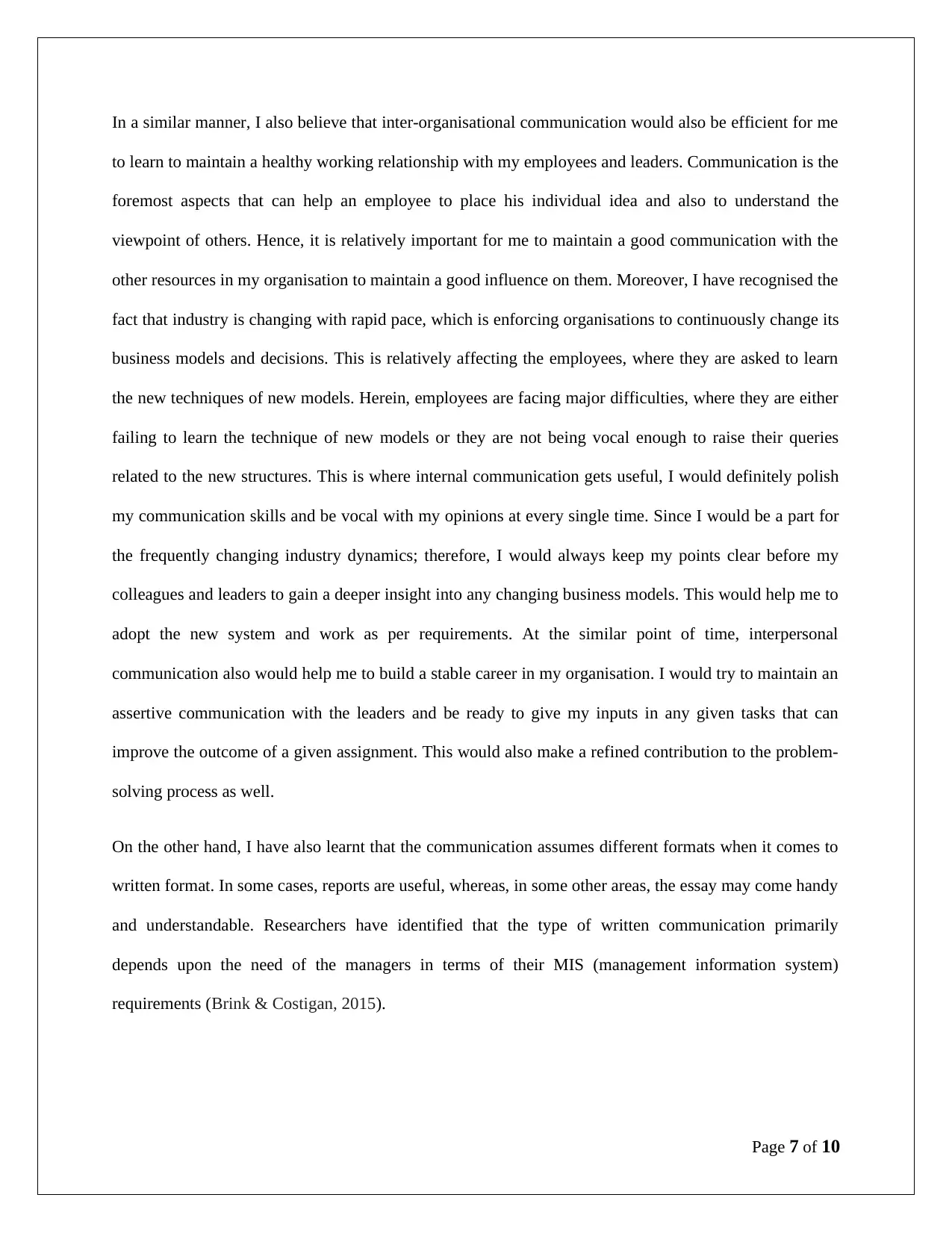
In a similar manner, I also believe that inter-organisational communication would also be efficient for me
to learn to maintain a healthy working relationship with my employees and leaders. Communication is the
foremost aspects that can help an employee to place his individual idea and also to understand the
viewpoint of others. Hence, it is relatively important for me to maintain a good communication with the
other resources in my organisation to maintain a good influence on them. Moreover, I have recognised the
fact that industry is changing with rapid pace, which is enforcing organisations to continuously change its
business models and decisions. This is relatively affecting the employees, where they are asked to learn
the new techniques of new models. Herein, employees are facing major difficulties, where they are either
failing to learn the technique of new models or they are not being vocal enough to raise their queries
related to the new structures. This is where internal communication gets useful, I would definitely polish
my communication skills and be vocal with my opinions at every single time. Since I would be a part for
the frequently changing industry dynamics; therefore, I would always keep my points clear before my
colleagues and leaders to gain a deeper insight into any changing business models. This would help me to
adopt the new system and work as per requirements. At the similar point of time, interpersonal
communication also would help me to build a stable career in my organisation. I would try to maintain an
assertive communication with the leaders and be ready to give my inputs in any given tasks that can
improve the outcome of a given assignment. This would also make a refined contribution to the problem-
solving process as well.
On the other hand, I have also learnt that the communication assumes different formats when it comes to
written format. In some cases, reports are useful, whereas, in some other areas, the essay may come handy
and understandable. Researchers have identified that the type of written communication primarily
depends upon the need of the managers in terms of their MIS (management information system)
requirements (Brink & Costigan, 2015).
Page 7 of 10
to learn to maintain a healthy working relationship with my employees and leaders. Communication is the
foremost aspects that can help an employee to place his individual idea and also to understand the
viewpoint of others. Hence, it is relatively important for me to maintain a good communication with the
other resources in my organisation to maintain a good influence on them. Moreover, I have recognised the
fact that industry is changing with rapid pace, which is enforcing organisations to continuously change its
business models and decisions. This is relatively affecting the employees, where they are asked to learn
the new techniques of new models. Herein, employees are facing major difficulties, where they are either
failing to learn the technique of new models or they are not being vocal enough to raise their queries
related to the new structures. This is where internal communication gets useful, I would definitely polish
my communication skills and be vocal with my opinions at every single time. Since I would be a part for
the frequently changing industry dynamics; therefore, I would always keep my points clear before my
colleagues and leaders to gain a deeper insight into any changing business models. This would help me to
adopt the new system and work as per requirements. At the similar point of time, interpersonal
communication also would help me to build a stable career in my organisation. I would try to maintain an
assertive communication with the leaders and be ready to give my inputs in any given tasks that can
improve the outcome of a given assignment. This would also make a refined contribution to the problem-
solving process as well.
On the other hand, I have also learnt that the communication assumes different formats when it comes to
written format. In some cases, reports are useful, whereas, in some other areas, the essay may come handy
and understandable. Researchers have identified that the type of written communication primarily
depends upon the need of the managers in terms of their MIS (management information system)
requirements (Brink & Costigan, 2015).
Page 7 of 10
Paraphrase This Document
Need a fresh take? Get an instant paraphrase of this document with our AI Paraphraser
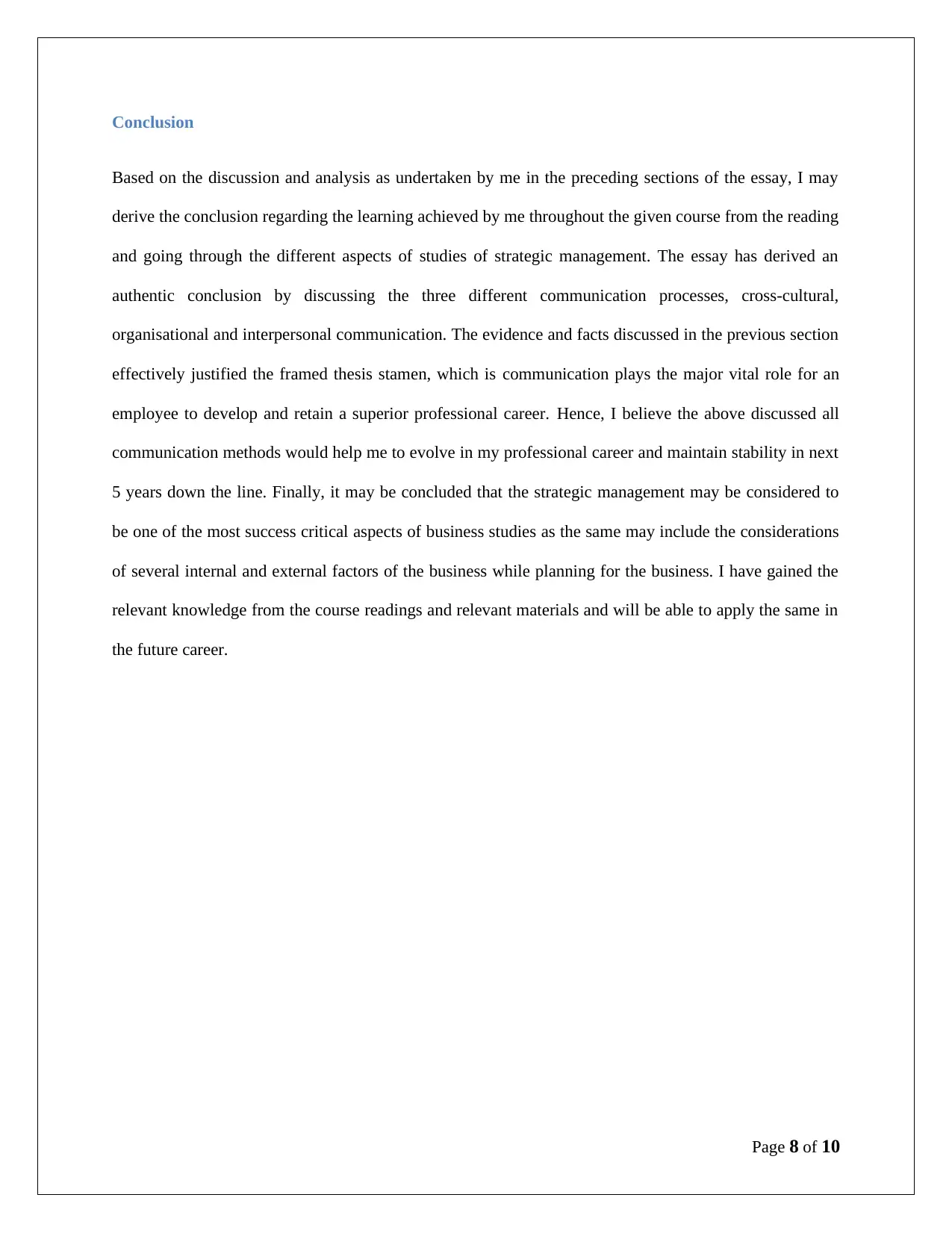
Conclusion
Based on the discussion and analysis as undertaken by me in the preceding sections of the essay, I may
derive the conclusion regarding the learning achieved by me throughout the given course from the reading
and going through the different aspects of studies of strategic management. The essay has derived an
authentic conclusion by discussing the three different communication processes, cross-cultural,
organisational and interpersonal communication. The evidence and facts discussed in the previous section
effectively justified the framed thesis stamen, which is communication plays the major vital role for an
employee to develop and retain a superior professional career. Hence, I believe the above discussed all
communication methods would help me to evolve in my professional career and maintain stability in next
5 years down the line. Finally, it may be concluded that the strategic management may be considered to
be one of the most success critical aspects of business studies as the same may include the considerations
of several internal and external factors of the business while planning for the business. I have gained the
relevant knowledge from the course readings and relevant materials and will be able to apply the same in
the future career.
Page 8 of 10
Based on the discussion and analysis as undertaken by me in the preceding sections of the essay, I may
derive the conclusion regarding the learning achieved by me throughout the given course from the reading
and going through the different aspects of studies of strategic management. The essay has derived an
authentic conclusion by discussing the three different communication processes, cross-cultural,
organisational and interpersonal communication. The evidence and facts discussed in the previous section
effectively justified the framed thesis stamen, which is communication plays the major vital role for an
employee to develop and retain a superior professional career. Hence, I believe the above discussed all
communication methods would help me to evolve in my professional career and maintain stability in next
5 years down the line. Finally, it may be concluded that the strategic management may be considered to
be one of the most success critical aspects of business studies as the same may include the considerations
of several internal and external factors of the business while planning for the business. I have gained the
relevant knowledge from the course readings and relevant materials and will be able to apply the same in
the future career.
Page 8 of 10
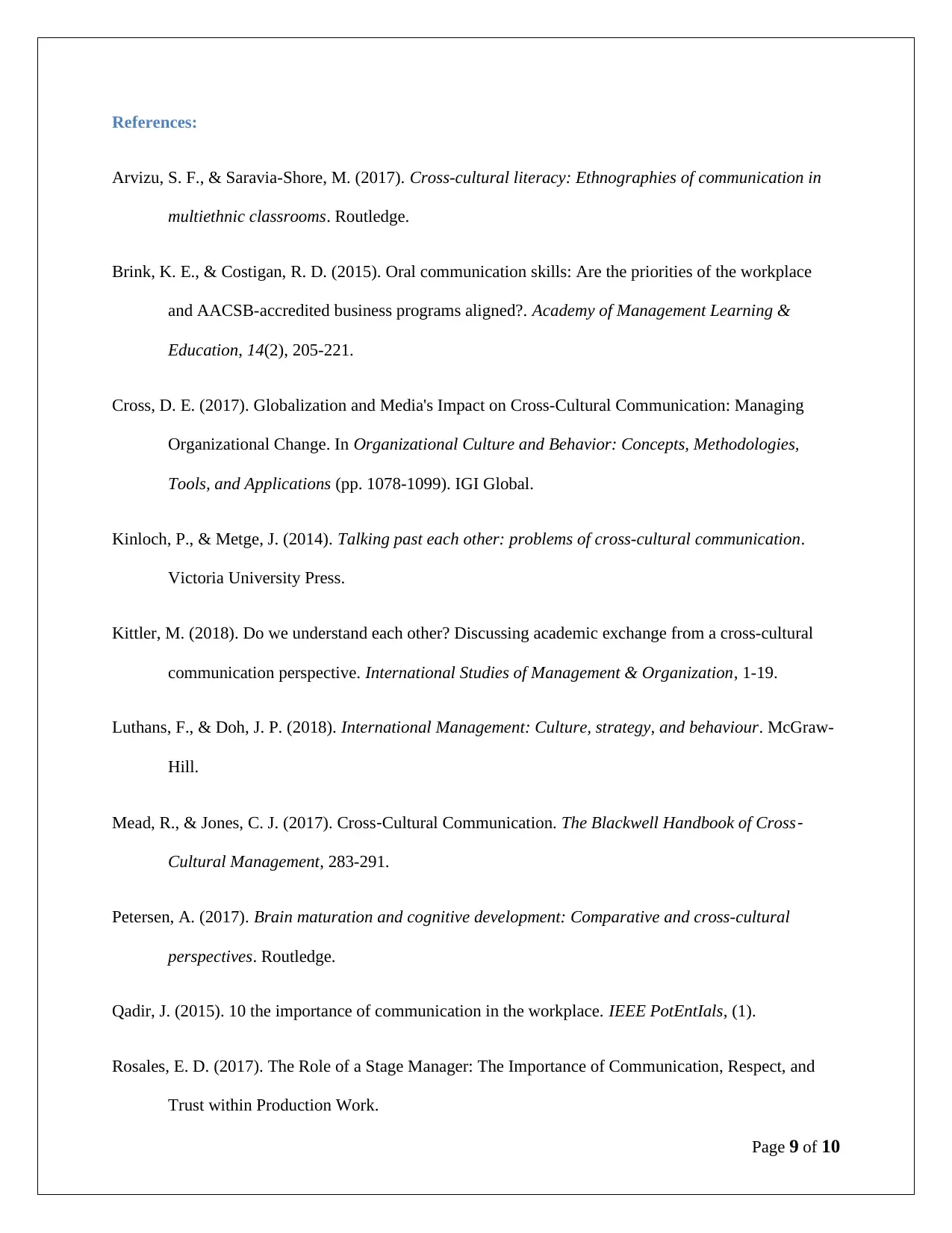
References:
Arvizu, S. F., & Saravia-Shore, M. (2017). Cross-cultural literacy: Ethnographies of communication in
multiethnic classrooms. Routledge.
Brink, K. E., & Costigan, R. D. (2015). Oral communication skills: Are the priorities of the workplace
and AACSB-accredited business programs aligned?. Academy of Management Learning &
Education, 14(2), 205-221.
Cross, D. E. (2017). Globalization and Media's Impact on Cross-Cultural Communication: Managing
Organizational Change. In Organizational Culture and Behavior: Concepts, Methodologies,
Tools, and Applications (pp. 1078-1099). IGI Global.
Kinloch, P., & Metge, J. (2014). Talking past each other: problems of cross-cultural communication.
Victoria University Press.
Kittler, M. (2018). Do we understand each other? Discussing academic exchange from a cross-cultural
communication perspective. International Studies of Management & Organization, 1-19.
Luthans, F., & Doh, J. P. (2018). International Management: Culture, strategy, and behaviour. McGraw-
Hill.
Mead, R., & Jones, C. J. (2017). Cross‐Cultural Communication. The Blackwell Handbook of Cross
‐
Cultural Management, 283-291.
Petersen, A. (2017). Brain maturation and cognitive development: Comparative and cross-cultural
perspectives. Routledge.
Qadir, J. (2015). 10 the importance of communication in the workplace. IEEE PotEntIals, (1).
Rosales, E. D. (2017). The Role of a Stage Manager: The Importance of Communication, Respect, and
Trust within Production Work.
Page 9 of 10
Arvizu, S. F., & Saravia-Shore, M. (2017). Cross-cultural literacy: Ethnographies of communication in
multiethnic classrooms. Routledge.
Brink, K. E., & Costigan, R. D. (2015). Oral communication skills: Are the priorities of the workplace
and AACSB-accredited business programs aligned?. Academy of Management Learning &
Education, 14(2), 205-221.
Cross, D. E. (2017). Globalization and Media's Impact on Cross-Cultural Communication: Managing
Organizational Change. In Organizational Culture and Behavior: Concepts, Methodologies,
Tools, and Applications (pp. 1078-1099). IGI Global.
Kinloch, P., & Metge, J. (2014). Talking past each other: problems of cross-cultural communication.
Victoria University Press.
Kittler, M. (2018). Do we understand each other? Discussing academic exchange from a cross-cultural
communication perspective. International Studies of Management & Organization, 1-19.
Luthans, F., & Doh, J. P. (2018). International Management: Culture, strategy, and behaviour. McGraw-
Hill.
Mead, R., & Jones, C. J. (2017). Cross‐Cultural Communication. The Blackwell Handbook of Cross
‐
Cultural Management, 283-291.
Petersen, A. (2017). Brain maturation and cognitive development: Comparative and cross-cultural
perspectives. Routledge.
Qadir, J. (2015). 10 the importance of communication in the workplace. IEEE PotEntIals, (1).
Rosales, E. D. (2017). The Role of a Stage Manager: The Importance of Communication, Respect, and
Trust within Production Work.
Page 9 of 10
⊘ This is a preview!⊘
Do you want full access?
Subscribe today to unlock all pages.

Trusted by 1+ million students worldwide
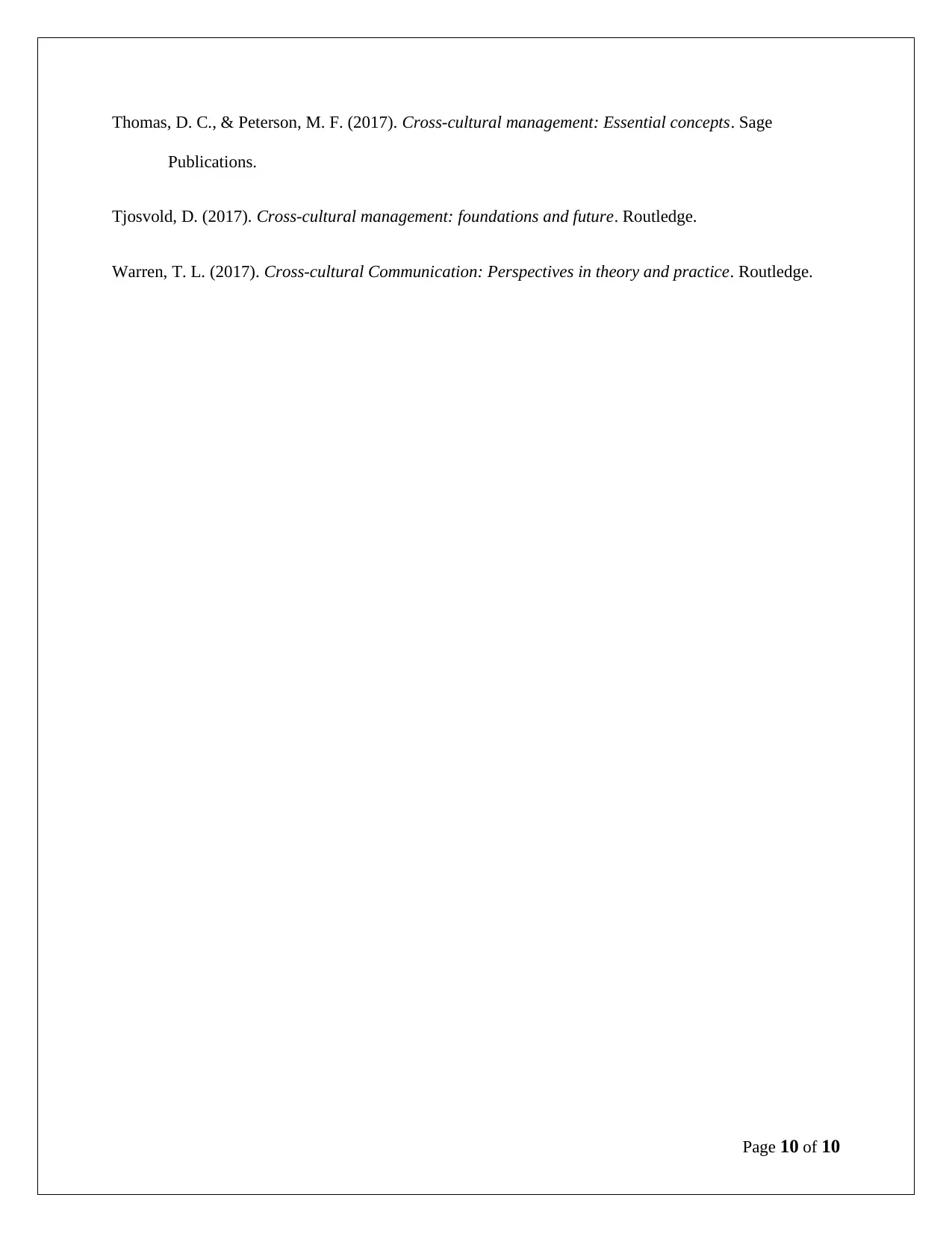
Thomas, D. C., & Peterson, M. F. (2017). Cross-cultural management: Essential concepts. Sage
Publications.
Tjosvold, D. (2017). Cross-cultural management: foundations and future. Routledge.
Warren, T. L. (2017). Cross-cultural Communication: Perspectives in theory and practice. Routledge.
Page 10 of 10
Publications.
Tjosvold, D. (2017). Cross-cultural management: foundations and future. Routledge.
Warren, T. L. (2017). Cross-cultural Communication: Perspectives in theory and practice. Routledge.
Page 10 of 10
1 out of 10
Related Documents
Your All-in-One AI-Powered Toolkit for Academic Success.
+13062052269
info@desklib.com
Available 24*7 on WhatsApp / Email
![[object Object]](/_next/static/media/star-bottom.7253800d.svg)
Unlock your academic potential
Copyright © 2020–2025 A2Z Services. All Rights Reserved. Developed and managed by ZUCOL.



